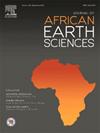Enigmatic encrusting fossils from the middle Devonian of Morocco: A new epibiont or peculiarly preserved ascodictyid microproblematica?
IF 2.2
4区 地球科学
Q2 GEOSCIENCES, MULTIDISCIPLINARY
引用次数: 0
Abstract
Devonian was a special time during which the sea floors were covered by numerous hard substrates, which provided the settlement of various encrusting and boring organisms. Although many of them are well-recognized and have their representatives in younger systems, some have still unresolved taxonomic affinities and thus represent problematic taxa. Here we present intriguing microfossils encrusting a brachiopod shell derived from the Middle Devonian carbonates of the Mader Basin, eastern Anti-Atlas, Morocco, which haven't been reported so far. The fossils have elongated, ribbon-like morphologies with characteristic lateral, tubular branches and are preserved as Fe-oxides/hydroxides casts after pyrite. The best-preserved specimens alone could have easily been taken as some completely new encrusting taxa. However, their association with some ascodictyids, a group of incertae sedis encrusters, and the presence of similar, but much less well-preserved branches located nearby on the same shell or occurring on other shells may indicate that the fossils described, may in fact only represent a differently preserved ascodictyid. If so, the fossils described suggest, that the same encrusting taxon may produce different taphomorphs even on the same small-sized substrate. Thus, finding such fossils alone may unnecessarily increase the diversity of the hard substrate community unless detailed and critical comparisons are made.
摩洛哥泥盆纪中期神秘的壳层化石:是一种新的表观生物还是特殊保存的ascodictymicroproblematica ?
泥盆纪是一个特殊的时期,在这个时期,海底被许多坚硬的底物所覆盖,这些底物提供了各种结壳和钻孔生物的定居。虽然他们中的许多人都得到了很好的认识,并且在较年轻的系统中有他们的代表,但有些人仍然没有解决分类上的亲和力,因此代表了有问题的分类群。在这里,我们展示了一种有趣的腕足类壳的微化石,这些微化石来自摩洛哥反阿特拉斯东部马德尔盆地中泥盆世碳酸盐岩,迄今尚未报道。这些化石具有细长的带状形态,具有典型的横向管状分支,并被保存为黄铁矿后的铁氧化物/氢氧化物铸造。仅保存最完好的标本就很容易被认为是一些全新的外壳分类群。然而,它们与一些ascodictyids,一组interinterae sedis外壳的联系,以及位于同一壳附近或发生在其他壳上的类似但保存较差的分支的存在,可能表明所描述的化石实际上可能只是代表一种保存不同的ascodictyids。如果是这样的话,所描述的化石表明,即使在相同的小尺寸基质上,相同的外壳分类群也可能产生不同的锥形。因此,单独发现这样的化石可能会不必要地增加硬基质群落的多样性,除非进行详细和关键的比较。
本文章由计算机程序翻译,如有差异,请以英文原文为准。
求助全文
约1分钟内获得全文
求助全文
来源期刊

Journal of African Earth Sciences
地学-地球科学综合
CiteScore
4.70
自引率
4.30%
发文量
240
审稿时长
12 months
期刊介绍:
The Journal of African Earth Sciences sees itself as the prime geological journal for all aspects of the Earth Sciences about the African plate. Papers dealing with peripheral areas are welcome if they demonstrate a tight link with Africa.
The Journal publishes high quality, peer-reviewed scientific papers. It is devoted primarily to research papers but short communications relating to new developments of broad interest, reviews and book reviews will also be considered. Papers must have international appeal and should present work of more regional than local significance and dealing with well identified and justified scientific questions. Specialised technical papers, analytical or exploration reports must be avoided. Papers on applied geology should preferably be linked to such core disciplines and must be addressed to a more general geoscientific audience.
 求助内容:
求助内容: 应助结果提醒方式:
应助结果提醒方式:


